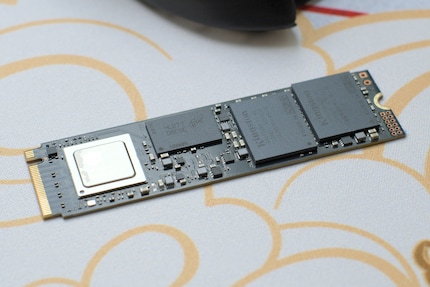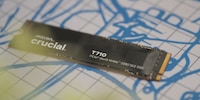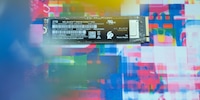

Kingston Fury Renegade G5 review: it’s tight at the top
With the Renegade G5, Kingston Fury is launching its first SSD for consumers with PCIe 5.0. In my test, the SSD impressed with its low power consumption and resulting cool temperatures.
After Samsung released its first consumer SSD with PCIe 5.0 two months ago, Kingston Fury is now following suit. According to the manufacturer, the Renegade G5 should offer up to 14.8 gigabytes per second (GB/s) when reading. At least with the 4-terabyte version (TB). My 2 TB test device offers up to 14.7 GB/s, which is still pretty speedy. The G5 even exceeds this theoretical value in the test, but it can’t quite keep up with the competition from Samsung and Crucial in many practical applications.
The technical details
One gigabyte (GB) of low power DDR4 DRAM is installed per TB of memory. This is where the data allocation tables, which record logical blocks and their positions in the memory, are stored, for example. So if you buy a different memory size, there may be differences in the specifications.
For the controller, Kingston relies on the SM2508 from Silicon Motion. Most other manufacturers rely on the E26 controller from Phison. The advantage of Kingston’s choice lies in the efficiency of the control unit: with a maximum of 9.5 watts for the 4 TB version, it’s significantly less hungry than Phison’s 12 watts.
Kingston relies on Kioxia BiCS8 TLC NAND for the flash. NAND is a non-volatile memory technology that doesn’t require power to store data. TLC stands for Triple Level Cell. This means 3 bits are allocated per memory cell, stacked over 218 layers.

Kingston promises 1,000 terabytes written (TBW) per TB of memory – that’s the number of TB that an SSD can write in its lifetime. These are conservative values, drives usually achieve more. With my test sample, I could technically write 1 TB of data per day for over three years. But that’s an unrealistic scenario. The manufacturer’s warranty lasts five years.
Read: middling
I measure read speed with the CrystalDiskMark program. This reveals that any differences between the PCIe 5.0 SSDs are minor. However, a gulf emerges for random reading: the Kingston SSD finishes in second place twice.
The first value in the graphic below refers to sequential reading, the second to random reading and writing. If you work with large files, the first bar will be relevant for you. For small files, check the second.
Write: one top, two flops
Writing is different from reading. Take our example: the G5 takes the lead in sequential writing, but comes last in random writing. I have to mention here that PCIe 5.0 SSDs in my tests are generally slower with random writes than those in the PCIe 4.0 standard, which seem to handle smaller files better.
As a practical test, I copy a 10-gigabyte file from a RAM disk to the SSD. The RAM disk ensures that the SSD is the bottleneck, since the disk will achieve a much higher write and read rate. Here, the G5 has to settle for last place again. Mind you, 5,000 MB/s is still pretty damn fast. As a rule, you only notice a difference in everyday use with large data volumes of 100 GB or more.
To test how the SSD behaves when writing data continuously, I repeatedly write the 10 GB test file from the RAM disk to the SSD using a batch command. This allows me to determine when it starts to throttle down. The G5 hits the brakes for the first time after only 20 GB of written data: instead of 5,000 megabytes per second (MB/s), it only reaches 4,500 MB/s. After 600 GB of written data, it throttles back to an average of 1,500 MB/s.
I’m disappointed that the SSD throttles down this quickly. At least it can maintain 4,500 MB/s for quite some time. Neither Samsung nor Crucial does this. The former throttles to 3,000 MB/s after 100 GB of written data, the latter to 3,500 MB/s after 200 GB.
Copy: Kingston victorious
When copying, i.e. reading and writing to the SSD at the same time, I duplicate the 10 GB file. Here, the G5 really sets itself apart from the other two.
Office: the G5 lags behind
The G5 struggles to keep up in Office applications. Bear in mind, all SSDs are lightning-fast here usually. You’ll hardly notice these benchmark differences in real life.
Gaming: second place again
Still, at least the G5 is only beaten by the T705 in the 3DMark gaming benchmark. I expected this based on the PCMark result. It’s probably down to weaker values for random access, which play a major role in everyday use.
How the SSD behaves at 80 per cent full
I ran all tests mentioned above with an empty SSD. As a rule, however, you’ll fill your drive over time. At 80 per cent full, the SSD will lose performance in any case. When reading, it’s around eight per cent less MB/s. For practical writing, ten per cent. At around five per cent, speeds are still the most similar when copying. In the Office test, on the other hand, I measured a drop in performance of around 13 per cent and eleven per cent for gaming. These are all similar values to those I noticed on other SSDs.
Temperatures: cool under pressure
Finally, the G5 impresses with its temperatures. Even during the continuous write test, it doesn’t get warmer than 63 degrees Celsius. That’s three degrees better than the Samsung SSD, but 23 degrees less than the Crucial SSD. This is due to the device’s lower power consumption, a maximum of seven watts for my 2 TB test sample. Since the 4 TB version has 2.5 watts more, slightly higher temperatures are to be expected there.
In a nutshell
Fast SSD, still too expensive right now
The G5 tops the list of PCIe 5.0 SSDs I’ve tested so far in terms of theoretical sequential writing. However, further tests show that theory isn’t the same as practice: except for copying, the new Kingston Fury mass storage device is always beaten by at least one competitor product. On the other hand, the SSD impresses with its low power consumption, which results in cool temperatures.
As the latest SSD in the group, the drive currently costs more than the competition from Samsung and Crucial. Personally, I’d go for the latter at the moment. Although it gets the hottest, it offers the best value for money. On the whole, these SSDs have little in common. If the price changes, I’d always go for the cheapest.
Pro
- High speeds
- Low power consumption, resulting in low operating temperature
Contra
- Expensive

From big data to big brother, Cyborgs to Sci-Fi. All aspects of technology and society fascinate me.


